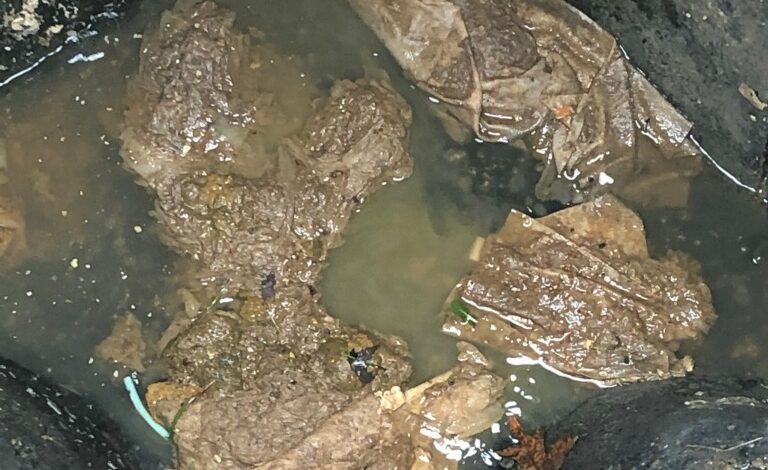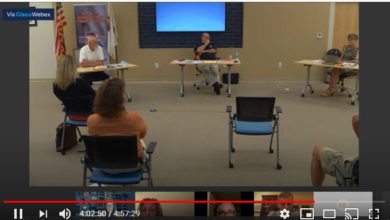Water District asks customers to not flush disposable wipes

The Sangamon Valley Public Water District is asking its customers to be cognizant about what they put down the toilet drain after having to clean out two sewage lines yesterday.
“We received two calls from two different households, who are users, and they called with a report of a slow drain; so when they flush the toilet, it was a very slow process to go down, wasn’t flushing like normal,” Sangamon Valley Public Water District Chairman Meghan Hennesy said. “And that’s actually your first indication that you might have something wrong with your sewer line.
The Water District’s small staff went out to see what was happening, both in the home and in the main sewer line to diagnose the problem.
“The two blockages that we investigated yesterday, happened to be within our main system and our main pipe,” Hennesy said.
The cause of the problem was flushable wipes that had been used instead of toilet paper. Regardless of what the packaging says, the Sangamon Valley Public Water District wants people to know that the use of wipes, feminine hygiene products and paper towels, among other items cause backups in a home system and the public system.
Hennesy said the decomposition of toilet paper and wipes can be seen when homeowners use them to clean surfaces. The wipes will hold their shape as they clean the sink, toilet or floor; but as soon as the toilet paper gets water on it, it clumps up and begins to break down.
“That’s actually what we want it to do when it goes into the sewer system, because it will dissipate,” Hennesy said. “And then it won’t cause a clog.”
When the wipes are flushed, or when several homes are using wipes and flushing them, they gather in the main pipe, and eventually can damage the system of several homes in any area.
Like on Monday, the Sangamon Valley Water Preserve District will open a manhole, see what the water and flow levels are, then have to take what Hennesy called a “big spoon” and pressured water to remove the waste from the system so that the sewage can flow appropriately.
In today’s world, that doesn’t just mean the staff has the job of working with sewage, it also means that they could be exposed to the COVID-19 virus.
The Journal of the American Medical Association noted that SARS-CoV-2, the virus that causes COVID-19, can be detected live in feces, meaning it can be transmitted through fecal matter.
“We do have gear, but just like everyone else, things like masks are hard to come by these days,” Hennesy said.
“We’re doing the best that we can.
“So, people refraining from flushing anything that’s not toilet paper is certainly a good way to partner with us.”
Hennesy suggested that if people have to find another way to wipe, they could still use the “disposable” wipes, but she asks that they be thrown in a lined trash can and disposed of quickly and properly instead of flushing them down the toilet.
“I know that that seems a little bit gross but it’s probably not as gross as the sewer backing up into your crawlspace or into your basement,” she said. “And those are very real possibilities if we have too many people who don’t take those measures.”
Using the right products to clean oneself helps alleviate some of the unnecessary work that the Sangamon Valley Water District has to do; freeing up their time to process payments, take time for customer service and provide a quality water product for their customers.
On March 10, the Water District put in place measures to protect the quality of its water and their employees by closing the office to the public, encouraging people to pay online and to use the dropbox located at Casey’s.
On Monday night, the District began to work in isolation at home or one-at-a-time at the office.
“We have a staff of five right now so there’s five people running the whole Water District. They’re incredibly dedicated staff,” Hennesy said. “They work very hard; they do a great job. But there’s limited numbers of us and because of that, we had to take what we felt were appropriate precautions to protect them.”
Customers who drive up to the gate off Prairieview Road will see that it’s closed until further notice. The Water District has changed their website for payments, and require those that pay by check to use the mail or dropbox.
“We are lucky in that we have the technology available to set people up with the tools that they need and they’re able to work out of their homes,” Hennesy said.
“The phones will still keep working. We have the ability to set up our office staff and they’ll be taking phone calls from their homes. We ask that our customers be a little bit patient; we’re working some kinks out. This is new to us.”
Although they are minimizing contacts, the Water District has made arrangements with local companies to not engage in face-to-face business until at least April 27.
“We’ve had great success with that,” she said.
Overall, she said the water district has run, and will continue to run, efficiently for customers.
“Our main focus is making sure that customers have access to clean water, and that your toilets work properly,” Hennesy said.
Unlike a taxing body, the Sangamon Valley Public Water District’s funds come from an exchange between product and payment.
“We are a user-based water system and so people paying their bills is really how we keep running,” she said.
“I know things might get interesting and tight for people, but if you can pay your water bill, that partnership with us goes a long way into helping us do what we need to do and keep the business running as usual.”
From the beginning of the COVID-19 crisis, the Sangamon Valley Public Water District had its hearts set on ensuring customers had access to water.
“We will work with customers to ensure that you have access to water, and we will set up a plan that works for you,” Hennesy said.
“We will do that in a way that allows us to maintain what we need from a business perspective, but that first and foremost protects our community because you are a community. And we want to protect you.
“We’re all in this together.”





